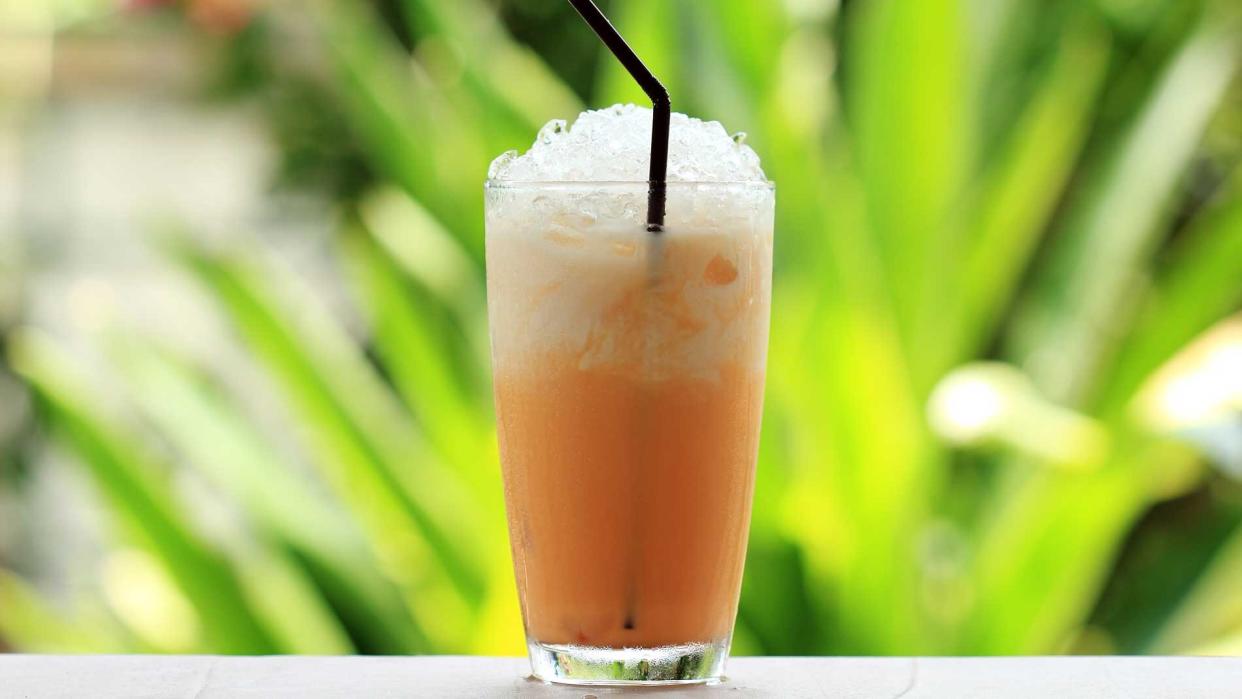All The Things You Really Should Know About Thai Iced Tea

? Getty Images/iStockphoto
The thing to know about Thai iced tea is that the version that you are probably familiar with—pinkish-orange and heavily spiced—is not exactly a quintessential Thai beverage. Like Chicken Tikka Masala or Egg Foo Young, the ubiquitous drink in Thai restaurants around the world is a culinary hybrid, intermixing a lowbrow Thai street tea with the western taste for sweetened and brightly colored iced beverages.
Thai Iced Tea History
Tea is a relatively new phenomenon in Thailand, brought in by the Chinese in the 1980s to supplant opium as a cash crop and thereby curb drug trafficking. It's unclear, exactly, when Thai tea (known in Thailand as Cha Yen)—a mixture of black tea, condensed milk, and sometimes ice—was invented, though many suspect it was a lingering influence from Field Marshal Pibul Songkram, a Thai leader with a penchant for western culture (hence the ice and milk). The tea became a staple of Thai street food culture, sometimes spiced with star anise and orange blossom water, but more often than not, served without any additional flavorings.
As Thai food became familiar throughout North America, Thai iced tea, too, gained widespread popularity. To appeal to American sensibilities, Thai chefs started spiking the drink with bright orange food coloring (the same one, it is said, used in Kraft macaroni and cheese), adding a heavy dose of spices to distinguish it from a standard American iced latte, and including tons more sugar. Thai iced tea in the prevalent form we know it as now was born.
Thai Iced Tea Preparation
In Thailand, the classic base for Thai iced tea is a strong black tea. Nowadays, the most popular local brand is the Number One Hand Brand, which incorporates a light amount of crushed spices in addition to tea leaves. The drink is made by placing the tea in a pot lined with a pantyhose filter (used commonly in Hong Kong milk tea), brewing the leaves for a long time, then adding condensed milk and crushed (never cubed) ice.
Unlike a lot of other cultures' tea preparations, Thai iced tea is not a drink that is typically made at home, according to Pim Techamuanvivit, the chef and proprietor of San Francisco's Kin Khao. More likely, you'll find it being sold out of street carts or coffee shops, served in glasses or plastic bags. ("Vendors will tie up one end of a plastic bag and stick a straw in the other end, or tie up the whole thing and poke a straw in the middle," Techamuanvivit says). In the morning, you'll often see the drink served hot, alongside fried dough for dipping; whereas on hot, humid afternoons, ice is added to turn it into a stimulating cooler. Techamuanvivit offers a version of Thai iced tea at Kin Khao, and her secret is using a blend of condensed milk and regular milk (sometimes known as "Thai cream," she says) to tone down the sweetness. No matter how you prepare it, though, Techamuanvivit describes the final product as consistently "silky and refreshing. It's not profound or anything, it doesn't take great skills to make; but it's delicious."
Thai Iced Tea in Culture
No matter how simplistic or fancy the spot, Thai iced tea is a ubiquitous menu offering at most Thai restaurants in the U.S.—like pad Thai or green curry, it's seen as an iconic part of the cuisine to Americans. That's not the case in Thailand, according to Techamuanvivit. "There, it's just another beverage," she says. "It's not this essential element of the culture, it's not something you even necessarily drink every day. But somehow it managed to catch the imagination of Americans, so it seems more important to them." Her theory as to its popularity here is that it's the perfect counterbalance for those who aren't used to all the heavy spices in Thai food. "It's just not something you would say, proudly, that you love in Thailand," she says. "Like in America, if you like Cheetos. That's not something you say out loud."
Still, Thai iced tea remains an incredibly beloved standalone flavor across North America, inspiring many a variety of dessert. In New York alone, you'll find everything from Thai Iced Tea Ice Cream at OddFellows Ice Cream Co. to Thai Iced Tea Crème Brulée at Spot Dessert Bar. At Kin Khao, Techamuanvivit is experimenting with a Thai Iced Tea soft serve with caramelized condensed milk and puffed brown rice—"It's cheeky, but yummy," she says.
Though Techamuanvivit is insistent that the traditional way to make Thai iced tea is without all the color and flavorings, she has noticed that in Thailand, because of the influx in American tourism, most restaurants end up serving the western version anyways. "It's interesting to look at, as it was something that was perceived as very Thai in the U.S., but then the U.S. version got transferred back to Thailand, and Thai people have just adapted." she says. "Thai tea is the perfect example of the way that cultures end up bleeding into each other."